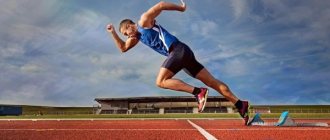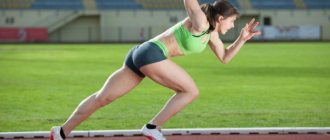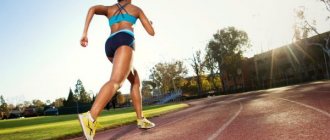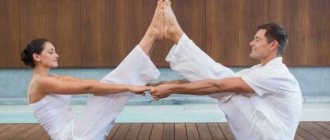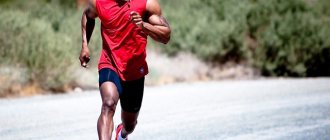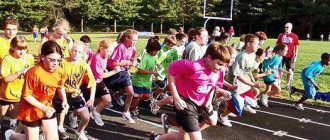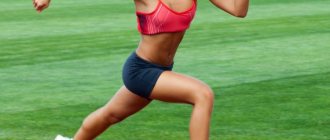The ability to run fast does not appear in people right away. It needs to be developed and trained. Even in adulthood you can learn this if you do everything right. Patience and regular training combined with proper technique will lead you to success. If your health is fine and running will not cause harm, then you can start training.
Let's start training
First of all, you need to train your legs well and increase your body's physical endurance. To do this, you can do the following exercises:
- It is best to train at a stadium or in a gym. You need to jump onto the bench with both feet together. After that, jump with a change of legs. All this must be done quickly so as not to linger on the bench or on the ground.
- Do weighted jumping jacks. For this you will need dumbbells. Take them and press them to your shoulders. So you need to carefully squat, doing it slowly. When you squat, jump up sharply, pushing off the ground as hard as possible. Push off with both feet at the same time. In addition, you can straighten your arms with dumbbells.
- Running with shin overlapping, as well as with legs raised, will help train your legs. This will help you learn the correct running technique. This needs to be done quickly. When running with your knees raised, they should reach chest level.
- Try to use only your shoulder joints when running. First, you need to practice in front of a mirror to simulate the movements of your arms as if you were running fast. Relax your fists and keep your body straight so that it does not follow your hands.
- To increase your stamina, jogging on low-elevation terrain will help you. Try to take about 30 steps in 20 seconds. Run for half an hour at first, and then gradually increase the run to one and a half hours.
- For endurance, also alternate running on flat terrain with uphill runs. Try to keep the distance approximately equal.
All of these exercises will help you prepare for fast sprinting. Anyone can learn this.
Don't forget about the psychological attitude. If you really want to learn how to run fast, you have to be positive about it.
Standards for the 100 meter race
Since the 100-meter dash is included in the list of regulated distances by the IAAF, grade standards for men and women have been developed specifically for this distance. To receive one of the ranks, you must show results corresponding to a specific rank.
Receiving any category does not require a strict sequence, i.e. Having shown a result that corresponds to the first adult category, the athlete will receive this, and will miss all the titles behind him.
It is worth remembering that the titles of CCM, MS and MSMK can only be obtained at competitions of the appropriate level. For example, CCM and MS can be obtained at regional competitions. To obtain the MSMC, you must reach the finals of International competitions, or run within the specified time in the semi-finals.
Below are the standards for men and women. You can view the breakdown of the categories, as well as view the full list of running standards here.
Women's standards
School standards have also been developed that take into account the physiological characteristics of the body’s maturation and the difference in speed and strength qualities between boys and girls.
As can be seen from the table, official standards for schools are developed only for grades 10-11. This does not mean that students in grades 9 and below cannot run a hundred meters, but any assessment in this case will be controversial.
We are working on the technical side
Before you attempt to run a short distance quickly, you need to warm up well. You need to feel free and warm. To this end, jog a few laps. No need to sprint yet. After this warm-up, run on your toes. This will help you practice running faster. Keeping your foot on the ground as little as possible will be better for running. It's like you should be floating. It will be easier if you run barefoot first. This way you will feel how you should run and feel the difference.
Another feature of the fast running technique is steps. There is a misconception that they need to be big in order to reach the finish line faster. However, this is not at all true. If you put too much distance between your steps while running, you'll quickly get out of shape. In this case, the leg that will be the first to fall to the ground will act as a brake. You will need to bear all your body weight on your feet, which can lead to sprains. The distance between steps should be average. Don't try to take big steps, let them be right. In this case, you will protect yourself from injury.
When running fast, correct torso position plays an important role. You need to lean forward a little. Don't do it too hard. If you can't do this, then at least don't lean back. This will reduce your running speed and also change your form for the worse.
Use your hands correctly. If you move them properly, they will help you speed up. They must always be in the correct L-shape, but inverted. At this moment, the fists should be relaxed and rise to the chin, and then lower down with the force of the elbows. You need to take into account that your arms should work in time with your legs. Then they will help carry you forward.
Proper breathing plays a big role. When accelerating, try to breathe faster. This will allow you to inhale more oxygen and help your muscles. You need to inhale through your nose and exhale through your mouth. If you stop breathing properly, your running speed will decrease.
Take time to stretch. Before running, you need to stretch properly for 5 minutes. You need to stretch your legs, neck, shoulders and ankles. This must be done in every workout, and especially in running. Here you use all the muscles of the body. This will help prevent injury.
The most important thing in the 60m sprint is not to slow down. If you feel that your speed is dropping, try to concentrate. Force yourself to run further. Before the finish line you need to speed up, making every effort.
One hundred meter running technique
Each of the sprint distances includes 4 stages from start to finish:
- Start
- Starting acceleration
- Distance running
- Finishing
Success is guaranteed to the athlete who perfectly completes each of the four stages. But in modern sprint there has never been such an athlete. Even the king of short distances, Usain Bolt, often loses to his opponents in the first 2 stages.
Biomechanics specialists attribute Bolt’s unsuccessful starts to his height, which exceeds the norm by 4 cm. It would seem that four centimeters cannot play such a significant role, but in fact, every time it affects the athlete’s results.
On this subject, Usain Bolt once said:
The athlete’s words are confirmed by numerous videos. Let's look at the example of a race in which the last current record was set in the 100-meter run with a result of 9.58 seconds according to auto timing.
Technique for overcoming 4 stages.
Start. Any distance in sprint running welcomes a low start. Moreover, at international competitions, a high start is completely unacceptable.
A low start allows you to gain significant speed without taking a single step. The better you can push off from the blocks, the more likely the athlete will show a good result.
Therefore, every sprinter pays great attention to how he starts
Starting acceleration. After leaving the start, the second stage begins, which involves gaining maximum speed in a minimum distance. To reach maximum speed, a professional sprinter needs 40-60 meters of distance.
“To gain speed faster, it is recommended to take three short steps from side to side with maximum frequency. At the same time, it is worth remembering that it is prohibited to step on the opponent’s track line.”
Running the distance. The stage that fans like more than others. It is at the third stage of the hundred-meter race that athletes show their maximum speed. The main task in this segment is not to lose the speed gained and maintain it until the finish.
Professional athletes never look around, because unnecessary movements cause a loss of speed, and therefore worsen the result in the finishing protocol.
Finishing. The last few meters of a sprint are rarely easy. It was thanks to the sprint that humanity had to invent a photo finish, which allows you to determine which of the athletes was first at the finish line by hundredths of a second.
There are two tricks that allow you to lose your opponents in the last centimeters of the distance.
The first trick is the chest throw. It consists of a sharp forward movement of the chest when finishing. In this case, the arms are pulled back and the head tilts forward. In fact, the first part of the body that crosses the finish line is the head, but for ease of understanding we decided to call it the chest throw, because the head throw sounds very ambiguous.
The second trick is finishing sideways. The essence is approximately the same, with the exception that the right shoulder is rotated forward. In this case, you need to be careful, since such a movement at high speed can lead to loss of coordination and a fall.
Each stage is important, but if you win one or two stages, there is no guarantee that you will be the first at the finish line. Using the example of Usain Bolt, you can see how, due to his phenomenal speed and ability to finish, he wins back 2 lost stages from his rivals.
A few more tips
If you want to take up running seriously and are sure that you will not give up this activity, then a few more tips will help you. Listen to them.
- Buy yourself shoes that are specifically designed for sprinting. It will be light and spiked. If you have a light weight underneath, you will be more comfortable running. Considering that you will have to spend a lot of time on your toes, such shoes will create all the conditions.
- It is necessary to dress correctly. You should feel comfortable and comfortable. Otherwise, the clothes will get in the way.
- Special blocks, which are often used by Olympic sprinters, will help you train.
- Run in company. This will awaken your competitive spirit and you will try to run faster. Even if the people you are trying to run the 60m with do it slowly, it will significantly increase the adrenaline in your blood.
- Record your time every time you practice. Try to improve your results every day. You can set your own record, then you will have a goal to overcome it.
- Drink as much as possible. It's especially important to drink plenty of water if your workouts take place in the sun.
Taking into account all the recommendations and performing preparatory exercises, you will be able to train quite quickly. Now you can quickly cover a distance of 60 meters and achieve good results.
Recommendations
How to learn to run 100 meters quickly
After the start, immediately pick up the speed with which you will move along the distance. If the race takes place at a competition, then it is advisable to gain a foothold among the leading athletes, since catching up is always more difficult than staying behind your opponent.
Before the race, distribute your strength and stick to the pace. The drop in pace should not be significant, otherwise it will be difficult to return to the required speed. Allowing yourself to rest and slow down is not a good idea for middle distance running.
100-200 meters before the finish, increase your step frequency. At the same time, control your energy consumption so that at the finish line you at least do not lose speed. After finishing, be sure to cool down by running slowly. This will allow the muscles to recover faster and relieve severe muscle pain the next day.
Constantly work not only on the physical component of training, but also on technical, tactical and psychological ones. Only training of all these components will allow you to show the best possible result, regardless of whether you pass the standard, participate in competitions or set personal records in individual runs.
How to learn to run long distances quickly (from 3000 m to marathon)
Many people are interested in how to run 3 km in less than 12 minutes. For these types of results, runners need to focus on training their speed, oxygen use efficiency, and aerobic strength.
The foundation for any stayer is volume: these are long cross-country runs, at least an hour, which must be run at least twice a week. Professional stayers gain 100-150 km per week. For amateurs, this figure is much less - about 40-60 km. It is impossible to show a 3 km result in less than 11 minutes if your weekly volume is 30 km.
Running uphill brings great benefits. It is better to use a gentle incline 300-500 m long and run up it 8-10 times so that the pace of each run is approximately the same, but not maximum. Rest between series – 3-4 minutes.
In addition to running training, you need to carry out a complex of general physical training to strengthen your hips, feet, and calf muscles. You will find 10 strength exercises for running with video useful.
Hand and body work
The back should be straight, the shoulders should be straightened, you should not hunch or slouch while running. This will help straighten the chest and allow maximum inhalation.
While running, you need to relax your legs and move them smoothly. The normal rate is 3 steps per second. In this case, the legs are slightly bent at the knees so that there is no pinching in the joint.
The arms should be bent at the elbows at a right angle and pressed to the body. There should be no tension in your elbows.
According to your personal feelings, your palms can be loosely clenched into fists (so that a tennis ball can fit inside your palm), or relaxed.
What do physical education lessons teach at school?
At primary school age, thanks to motor activity, muscle and bone tissue develops more actively, metabolic processes in the body are stimulated, and its protective properties increase. Without specially organized and regular exercises, it is impossible to achieve the level of fitness that systematically engages in physical exercise.
If a child does not regularly engage in physical exercise, then lack of movement leads to decreased growth of the body, and sometimes to muscle atrophy and obesity. However, an excessively large load is harmful, since at this age a large amount of energy is needed, first of all, for the processes of growth and development.
School physical education lessons improve health, develop physical qualities, and contribute to the formation of motor skills.
Physical education lessons provide knowledge both about the field of physical education and about sports in general, a healthy lifestyle, form organizational skills, introduce them to independent activities, and develop character.
Running exercises allow the cardiovascular system, musculoskeletal system, respiratory system and other body systems to develop evenly. Cyclic exercises improve breathing mechanisms, increase vital capacity, increase the volume of the chest and its excursion. Regular exercise improves nervous processes and contributes to the formation of mental and emotional stability.
Dosing the load, selecting exercises and constantly monitoring signs of fatigue allows you to apply a differentiated approach to students.
Physical education lessons provide an opportunity to compensate for the lack of motor activity that arises during the educational process.
Regular exercise, both at school and at home, increases resistance to pathogenic factors and allows you to recover faster in case of illness.
You can do running exercises almost anywhere: indoors, at a stadium, a small sports ground, in a park or outside the city, and there is no need to purchase any additional and expensive sports equipment.
Physical education often contributes to the discovery of sports talents, which are further supported and developed by experienced teachers. This is how ordinary schoolchildren often become famous athletes and champions in the future.
Exercising has a positive effect on the body. Thanks to regular exercises, the muscular and skeletal system is strengthened, metabolism is improved, the range of mobility of the joints and spine increases, and rhythmic and deep breathing promotes better blood circulation.
Thus, physical education in general and running exercises in particular are a simple and accessible means of physical education that has a positive effect on the body in a wide range of loads, and control standards allow you to monitor the dynamics of physical development and correctly distribute the load on students during classes.
Pre-IAAF
| Time | Athlete | date | Place | |
| Pre-IAAF ratified records (pre-1966) | ||||
| 6.6 | Jesse Owens (United States of America) | February 23, 1935 | New York, United States | |
| Ben Jonson (United States of America) | February 23, 1935 | |||
| February 26, 1938 | ||||
| Herbert Thompson(United States of America) | February 25, 1939 | |||
Shoes for 400m running
Sprinters run in spikes - special hard shoes with spikes on the sole. But, as usual, there should be different shoes for different disciplines. Because the 400m is a long sprint, the spikes are not the same as for 100m runners.
They have a thicker heel and a less rigid sole. In the 400m sprint, athletes run two turns, which also affects the structure of their shoes: they need more serious grip.
Here are some models that have proven to be the best:
- Nike Zoom 400
- adidas Finesse
- Nike Superfly Elite
- Nike Zoom JA
- Under Armor Speedform Sprint 2
- New Balance Vazee Verge V1
- Saucony Spitfire 5
Running technique
In this discipline, it is important to change your running technique when the body is already tired and the muscles are “clogged” with lactic acid. Working out the technique affects all 4 stages of running:
Working out the technique affects all 4 stages of running:
- Start;
- Starting run;
- Running along the main part of the distance;
- Finishing.
Start and starting run
It is customary to start the race from a high start. The athlete places the starting leg at the start line, the second leg is located directly behind the starting leg and stands on the toe at a distance of one foot. The legs are slightly bent at the knees, the center of gravity is moved forward.
Arm position: the arm on the side of the pushing leg is bent at the elbow and brought forward. The shoulder on the same side also moves forward. The other hand should be brought back.
It makes sense to develop maximum speed only at 60-70 meters of distance, since otherwise the muscles will acidify too quickly and the athlete will get tired faster than acceptable.
Distance running
The main part of distance running is characterized by an almost vertical body position. The maximum forward deviation from the vertical is no more than 4-5 degrees. At the same time, the arms are bent and move at the same speed as the legs.
When running along a bend, the athlete's body tilts slightly towards the inside of the track, the right hand moves more actively and is also directed towards the inside of the track. The right foot is characterized by a heel-out position.
At this stage, the actions of the arms and legs are characterized by maximally free, relaxed, sweeping movements.
Finishing
The body leans forward more and the stride length increases after about half the run.
At this stage, running in its technique is more and more similar to sprinting. Some athletes practice throwing or snatching onto a ribbon. To successfully complete the final stage of the race, finishing acceleration is deliberately trained.
Safety precautions
You should not move on to interval or speed work without any running training.
Jack Daniels, author of the book “From 800 Meters to the Marathon,” advises including speed work in preparation for long races only when the volume of running per week regularly reaches 40-50 km. In this case, speed work should be no more than 8% of the total weekly mileage. But this is precisely interval, intense running with alternating acceleration and rest.
Speed training must be preceded by a warm-up - light jogging for at least 10 minutes and joint exercises.
There are certain rules of behavior on the tracks - you cannot go onto someone else’s track during competitions. Collisions at these speeds almost always result in injury.
We have already written about shoes - they must fit perfectly to the foot. Choosing shoes for sprints is an important part of protecting yourself from injury. Sneakers must be the correct size and well laced.
Those runners who have recently suffered an injury should take special care when starting speed work. If you are not sure that everything has passed, you cannot proceed to speed
Sprinting is a serious impact load, and it can negate all the progress in treatment.
Notes[edit]
- ↑
Kelly ran 6.6 in his semi-final at the European Indoor Games and again in the final with Erbstesser and Kassatkin; the photo finish placed Kelly in first place, Erbstoeser in second, and Kassatkin in third, with each man given a value equal to the world record. - ↑
This time, along with his 6.44 on the same day and 6.41 in 1987, it was canceled in September 1989 after Johnson admitted to using steroids between 1981 and 1988. - Woronin's performances have not been regarded as world-class records/records since Ben Johnson ran 6.50 and 6.44 in January 1986. Johnson ran ten times in the 6.41-6.50 range between 1986 and 1988, but all of them were canceled after his admission to steroid use .
- The time is rejected as a record because the starting blocks were not connected and drug testing was not performed immediately after the race.
World records
The 2000 m race is not included in the program of the Olympic Games and the World Athletics Championships, but now the distance is regularly included in commercial competitions. So the 2000m still has a lot of room for improvement.
Men
Hisham El Guerrouj (Morocco) – 04:44.79 (1999, Berlin)
Women
Genzebe Dibaba (Ethiopia) – 05:23.75 (2017, Edinburgh)
The European records in the men's and women's categories are held, respectively, by the young Norwegian runner Jakob Ingebrigtsen (04:50.01, sixth fastest in history, 2022) and Sonia O'Sullivan from Ireland (05:25.36, second fastest in history, 1994).
Jakob Ingebrigtsen sets a new European record in the 2000m race
In the top 10 results in the women's 2000 m race, Soviet athletes Tatyana Kazankina (05:28.72, 1984) and Tatyana Pozdnyakova (05:29.64, 1984) appear in 6th and 7th places.
Standards
Men
| Manual timing | KMS | I | II | III | I(yu) | II(yu) | III(ju) |
| 30 m | – | – | – | 4,2 | 4,4 | 4,7 | 5,0 |
| 60 m | 6,8 | 7,1 | 7,4 | 7,8 | 8,2 | 8,7 | 9,3 |
| Auto timing | MSMK | MS | KMS | I | II | III | I(yu) | II(yu) | III(ju) |
| 30 m | – | – | – | – | – | – | – | – | – |
| 60 m | 6,68 | 6,84 | 7,04 | 7,34 | 7,64 | 8,04 | 8,44 | 8,94 | 9,54 |
Women
| Manual timing | KMS | I | II | III | I(yu) | II(yu) | III(ju) |
| 30 m | – | – | – | 4,9 | 5,1 | 5,3 | 5,6 |
| 60 m | 7,6 | 8,0 | 8,4 | 8,9 | 9,4 | 9,9 | 10,5 |
| Auto timing | MSMK | MS | KMS | I | II | III | I(yu) | II(yu) | III(ju) |
| 30 m | – | – | – | – | – | – | – | – | – |
| 60 m | 7,28 | 7,50 | 7,84 | 8,24 | 8,64 | 9,14 | 9,64 | 10,14 | 10,74 |
GTO standards for 30 and 60 m
As in physical education lessons, in the “Ready for Labor and Defense” complex, the 30 m run is the main athletics event, present in tests from the very 1st age level (6-8 years) and up to the 8th (45- 49 years old). Let us remind you that there are only 11 steps in the GTO, the last of which is “70 years and older.”
It must be said that the GTO does not require passing standards for both distances. They are, of course, mandatory, but the test taker can choose one of them. If you choose to run the 60m, you cannot take the 30m, and vice versa.
30m sprint
| Age | Boys/Men | Girls/Women | ||||
| Gold | Silver | Bronze | Gold | Silver | Bronze | |
| 6-8 years | 6,0 | 6,7 | 6,9 | 6,2 | 6,8 | 7,1 |
| 9-10 years | 5,4 | 6,0 | 6,2 | 5,6 | 6,2 | 6,4 |
| 11-12 years old | 5,1 | 5,5 | 5,7 | 5,3 | 5,8 | 6,0 |
| 13-15 years old | 4,7 | 5,1 | 5,3 | 5,0 | 5,4 | 5,6 |
| 16-17 years old | 4,4 | 4,7 | 4,9 | 5,0 | 5,5 | 5,7 |
| 18-24 years old | 4,3 | 4,6 | 4,8 | 5,1 | 5,7 | 5,9 |
| 25-29 years old | 4,6 | 5,0 | 5,4 | 5,4 | 6,1 | 6,4 |
| 30-34 years | 4,9 | 5,7 | 6,3 | 5,7 | 6,8 | 7,3 |
| 35-39 years old | 5,2 | 6,3 | 7,1 | 5,9 | 7,2 | 7,9 |
| 40-44 years* | 5,6 | 7,3 | 7,9 | 6,2 | 7,9 | 8,5 |
| 45-49 years old* | 6,0 | 7,6 | 8,1 | 6,5 | 8,2 | 8,7 |
60m sprint
| Age | Boys/Men | Girls/Women | ||||
| Gold | Silver | Bronze | Gold | Silver | Bronze | |
| 9-10 years | 10,4 | 11,5 | 11,9 | 10,8 | 12,0 | 12,4 |
| 11-12 years old | 9,5 | 10,4 | 10,9 | 10,1 | 10,9 | 11,3 |
| 13-15 years old | 8,2 | 9,2 | 9,6 | 9,6 | 10,4 | 10,6 |
| 16-17 years old | 8,0 | 8,5 | 8,8 | 9,3 | 10,1 | 10,5 |
| 18-24 years old | 7,9 | 8,6 | 9,0 | 9,6 | 10,5 | 10,9 |
| 25-29 years old | 8,2 | 9,1 | 9,5 | 9,9 | 10,7 | 11,2 |
| 30-34 years | 8,9 | 11,1 | 12,1 | 10,7 | 12,3 | 12,9 |
| 35-39 years old | 9,2 | 11,5 | 12,5 | 10,9 | 12,6 | 13,2 |
| 40-44 years* | 9,6 | 12,0 | 12,8 | 11,5 | 13,2 | 13,8 |
| 45-49 years old* | 11,1 | 13,5 | 14,4 | 11,6 | 14,0 | 14,9 |
* for the age category of 40-49 years, both men and women, running 30 and 60 m is not a compulsory event. It is performed by choice.
How the competition works
Official 60-meter races take place indoors on a straight section of the 200-meter course or a separate running segment of the track.
In the GTO, standards for these distances are adopted at a stadium, in an arena or on any flat ground. 2-4 people can start at the same time. For the 30-meter distance, a high start is provided, but the 60-meter run can be started from either a high or low start.
We have already looked at what a low start looks like. Separately, it is necessary to mention the effective high start.
With a high start, the strong leg is put forward, the toe is located close to the starting line. The other leg is two feet away from the line, with the feet of both legs parallel or slightly turned inward. The distance between them should not be greater than the width of the foot.
At the “Attention” command, the body weight is transferred to the forefoot of the leg in front, the other foot rests its toe on the ground. Both legs are slightly bent at the knees, the body is tilted forward (the head and shoulders are slightly lowered down), the arms are bent at the elbows, and the hand opposite the leg in front is brought forward, and the other is placed behind the body
It is necessary to maintain maximum relaxation of the muscles involved while taking the starting position.
On the command “March!” running begins with a wide and fast swing of the arms while simultaneously pushing off strongly with both legs.
How to run correctly
Proper foot placement during sprinting reduces the likelihood of injury. When running, you should not feel any kickback in your foot. There are three types of foot placement techniques:
The first technique of planting the foot, in which the spring effect is triggered, is considered the most effective. This achieves the best shock absorption when the foot hits the ground, and the foot is pushed upward without delay on the surface. You can figure out the correct placement of the foot by jogging barefoot on a hard surface. Each person’s foot has its own individual characteristics and, in this case, the best option for positioning the foot will be suggested by nature itself.
Pressing your feet towards the middle or front is the most natural running style. It is also the fastest and most efficient way of working. Choose the right running shoe size. There should be a gap of 4 to 6mm between the front of your shoe and the longest toe, about the width of your big toe.
Your foot should rest on the center of the activation lugs located on the bottom of the shoe. If necessary, add an orthopedic pillow model. If you are using an orthopedic pillow, remove the original insole and insert a special sports orthopedic pillow. Practice proper running technique. Relax, lean forward slightly and slow down your pace. The foot naturally hits the center of the foot at a point at right angles below the pan. Maintain a higher stride and a short stride.
High speed during sprinting is regulated by frequency and stride length. During the race, your hips must be separated from each other as wide as possible - this will allow you to take longer steps. You don't need to fully extend your knees, as fully straightening your legs when running will affect your speed and lead to rapid fatigue.
As you lower your leg, your torso must be kept vertical, directly above the point where your foot contacts the surface. This position will allow you to make a strong push and continue to accelerate. The movement of the hands is free, they should move as nature dictates. Your back should be kept straight and your torso should remain motionless.
